window HONDA CIVIC COUPE 2015 9.G Owners Manual
[x] Cancel search | Manufacturer: HONDA, Model Year: 2015, Model line: CIVIC COUPE, Model: HONDA CIVIC COUPE 2015 9.GPages: 441, PDF Size: 18.4 MB
Page 4 of 441
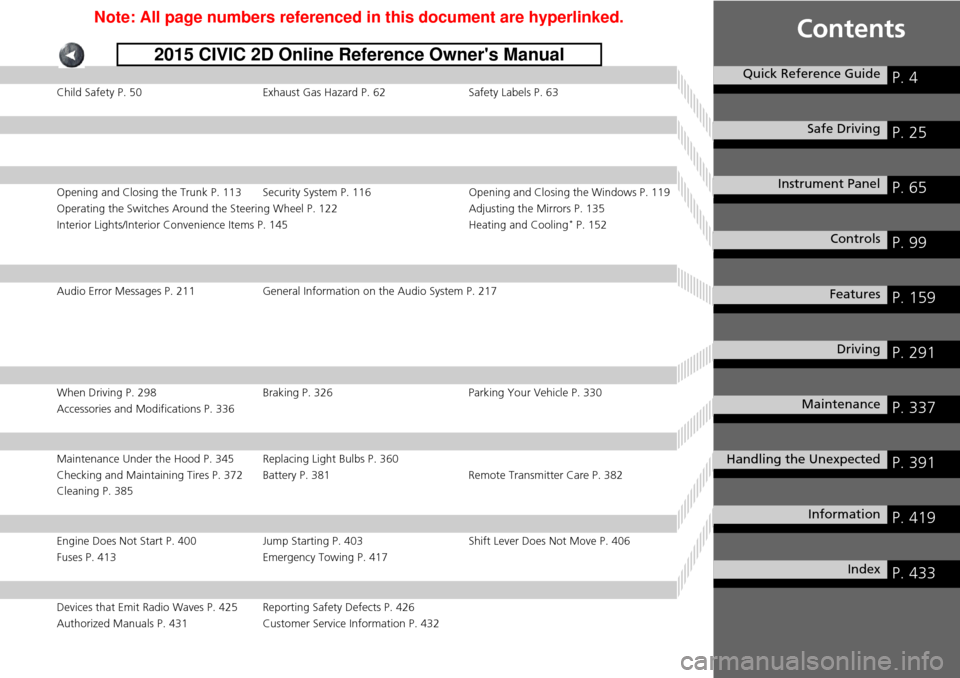
Contents
Child Safety P. 50Exhaust Gas Hazard P. 62Safety Labels P. 63
Opening and Closing the Trunk P. 113 Security System P. 116 Opening and Closing the Windows P. 119
Operating the Switches Around the Steering Wheel P. 122 Adjusting the Mirrors P. 135
Interior Lights/Interior Convenience Items P. 145 Heating and Cooling
* P. 152
Audio Error Messages P. 211General Information on the Audio System P. 217
When Driving P. 298 Braking P. 326Parking Your Vehicle P. 330
Accessories and Modifications P. 336
Maintenance Under the Hood P. 345 Replacing Light Bulbs P. 360
Checking and Maintaining Tires P. 372 Battery P. 381 Remote Transmitter Care P. 382
Cleaning P. 385
Engine Does Not Start P. 400 Jump Starting P. 403 Shift Lever Does Not Move P. 406
Fuses P. 413 Emergency Towing P. 417
Devices that Emit Radio Waves P. 425 Reporting Safety Defects P. 426
Authorized Manuals P. 431 Customer Service Information P. 432
Quick Reference GuideP. 4
Safe DrivingP. 25
Instrument PanelP. 65
ControlsP. 99
FeaturesP. 159
DrivingP. 291
MaintenanceP. 337
Handling the UnexpectedP. 391
InformationP. 419
IndexP. 433
Page 5 of 441

4Quick Reference Guide
Quick Reference GuideVisual Index*1:
Models with the smart entry system have an ENGINE START/STOP button instead of an ignition switch.
❙Hazard Warning Button❙Seat Heater Switches
* (P151)
❙Ignition Switch
*1 (P122)
❙
(Vehicle Stability Assist (VSA ®)
System OFF) Button
* (P319)
❙ECON Button
* (P314)
❙
(Vehicle Stability Assist (VSA ®)
System OFF) Button
* (P319)
❙Steering Wheel Adjustments (P134)❙Navigation System
*
() See Navigation System Manual❙Audio System
(P166, 184)
❙Rear Window Defogger
(P133)
❙Heated Mirror Button
* (P133)
❙Heating and Cooling System
*
(P152)❙Climate Control System
* (P155)
❙intelligent Multi-Information
Display (i-MID)
(P83)
❙ENGINE START/STOP Button
*1 (P123)
❙System Indicators
(P66)
❙Gauges
(P81)
Page 7 of 441

Visual Index
6Quick Reference Guide
❙Passenger's Front Airbag (P40)❙Glove Box
(P147)
❙Shift Lever
Continuously Variable
Transmission
(P305, 307)
Manual Transmission (P311)
❙Hood Release Handle
(P347)
❙Fuel Fill Door Release Handle
(P333)
❙Driver’s Pocket❙Trunk Release
(P113)
❙Driver's Front Airbag
(P40)
❙Door Mirror Controls
(P135)
❙Power Door Lock Master Switch
(P111)
❙Power Window Switches
(P119)
❙Parking Brake
(P326)
❙Interior Fuse Box
(P414)
❙Rearview Mirror
(P135)
❙Accessory Power Socket (P150)❙Auxiliary Input Jack
* (P162)
❙USB/HDMI® Port
* (P161)
Page 14 of 441
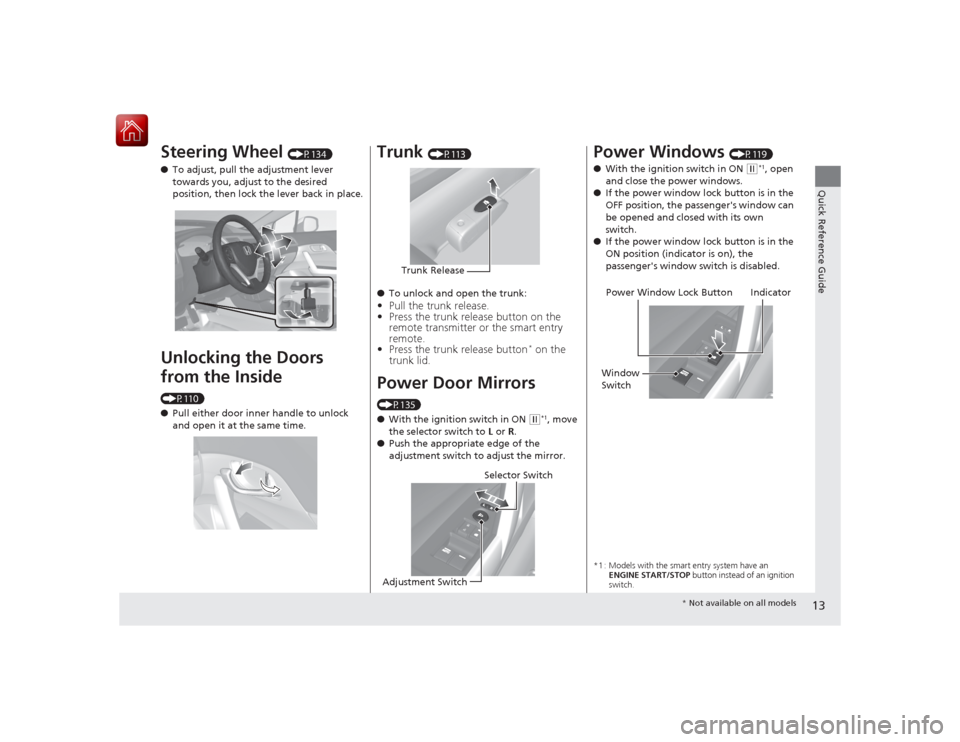
13Quick Reference Guide
Steering Wheel
(P134)
● To adjust, pull th e adjustment lever
towards you, adjust to the desired
position, then lock the lever back in place.
Unlocking the Doors
from the Inside (P110)
● Pull either door inner handle to unlock
and open it at the same time.
Trunk
(P113)
● To unlock and open the trunk:
•Pull the trunk release.
• Press the trunk release button on the
remote transmitter or the smart entry
remote.
• Press the trunk release button
* on the
trunk lid.
Power Door Mirrors (P135)
● With the ignition switch in ON
(w*1, move
the selector switch to L or R .
● Push the appropriate edge of the
adjustment switch to adjust the mirror.
Trunk Release
Selector Switch
Adjustment Switch
Power Windows
(P119)
● With the ignition switch in ON
(w*1, open
and close the power windows.
● If the power window lock button is in the
OFF position, the passenger's window can
be opened and closed with its own
switch.
● If the power window lock button is in the
ON position (indicator is on), the
passenger's window switch is disabled.
*1 : Models with the smart entry system have an
ENGINE START/STOP button instead of an ignition
switch.
Power Window Lock Button
Window
Switch Indicator
*
Not available on all models
Page 15 of 441
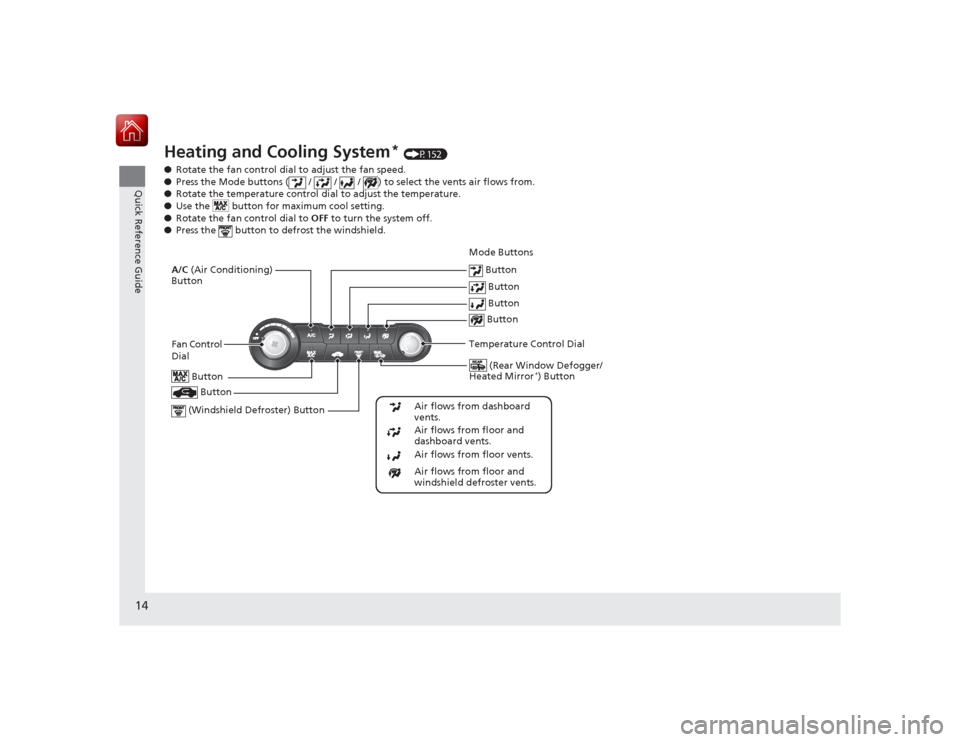
14Quick Reference Guide
Heating and Cooling System
* (P152)
● Rotate the fan control dial to adjust the fan speed.
● Press the Mode buttons ( / / / ) to select the vents air flows from.
● Rotate the temperature control dial to adjust the temperature.
● Use the button for maximum cool setting.
● Rotate the fan control dial to OFF to turn the system off.
● Press the button to defrost the windshield.
Fan Control
Dial
(Rear Window Defogger/
Heated Mirror
*) Button
(Windshield Defroster) Button
A/C (Air Conditioning)
Button
Air flows from floor and
windshield defroster vents.
Air flows from floor vents. Air flows from floor and
dashboard vents. Air flows from dashboard
vents.
Button Button
Button Button
Temperature Control Dial Button
Button
Mode Buttons
Page 16 of 441
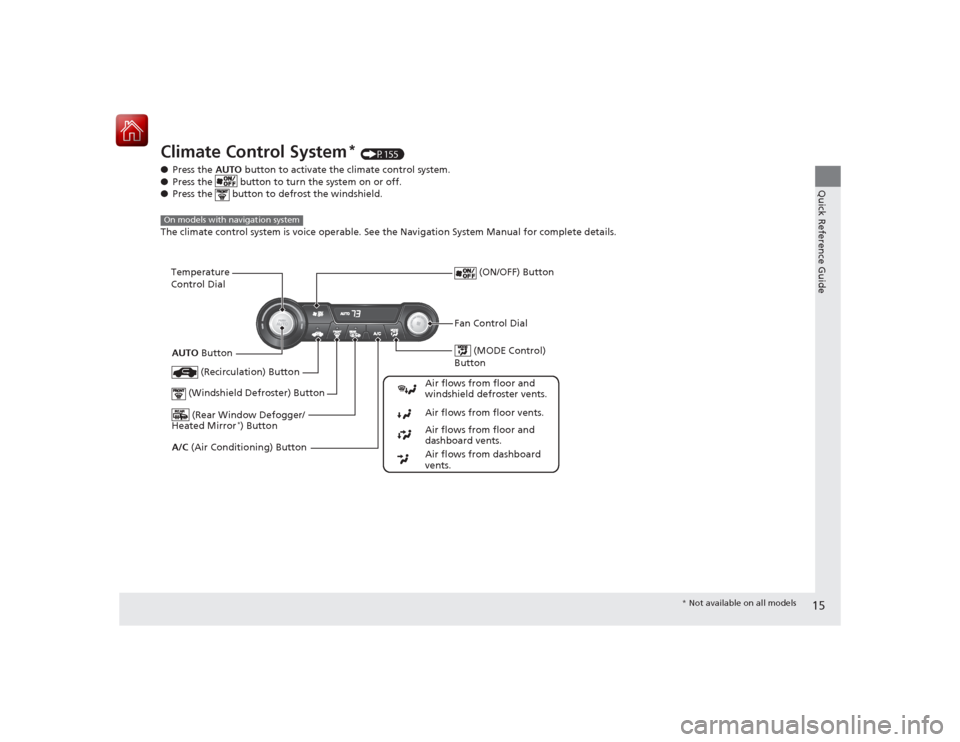
15Quick Reference Guide
Climate Control System
* (P155)
● Press the AUTO button to activate the climate control system.
● Press the button to turn the system on or off.
● Press the button to defrost the windshield.
The climate control system is voice operable. See the Navigation System Manual for complete details.
On models with navigation system
(MODE Control)
Button
(Rear Window Defogger/
Heated Mirror
*) Button
(Windshield Defroster) Button
A/C (Air Conditioning) Button Air flows from floor and
windshield defroster vents.
Air flows from floor vents.
Air flows from floor and
dashboard vents.
Air flows from dashboard
vents.
(Recirculation) Button
Temperature
Control Dial
AUTO Button (ON/OFF) Button
Fan Control Dial
*
Not available on all models
Page 39 of 441

38
uuAirbags uAirbag System Components
Safe Driving
The front, front side, and side curtain
airbags are deployed according to the
direction and severity of impact. Both side
curtain airbags are deployed in a rollover.
The airbag system includes:aTwo SRS (Supplemental Restraint System)
front airbags. The driver's airbag is stored
in the center of the steering wheel; the
front passenger's airbag is stored in the
dashboard. Both are marked SRS
AIRBAG.bTwo side airbags, one for the driver and
one for a front passenger. The airbags are
stored in the outer edges of the seat-
backs. Both are marked SIDE AIRBAG .cTwo side curtain airbags, one for each
side of the vehicle. The airbags are stored
in the ceiling, above the side windows.
The front and rear pillars are marked
SIDE CURTAIN AIRBAG.
dAn electronic control unit that continually
monitors and can record information
about the sensors, the airbag activators,
the seat belt tensioners, and driver and
front passenger seat belt use when the
ignition switch is in ON
(w
*1.
eAutomatic front seat belt tensioners. The
driver's and front passenger's seat belts
incorporate sensors that detect whether
or not they are fastened.fA driver's seat position sensor. If the seat
is too far forward, the airbag will inflate
with less force.gWeight sensors in the front passenger's
seat. The front passenger's airbag will be
turned off if the weight on the seat is 65
lbs (29 kg) or less (the weight of an infant
or small child).
hImpact sensors that can detect a
moderate-to-severe front or side impact.iAn indicator on the dashboard that alerts
you that the front passenger's front
airbag has been turned off.jAn indicator on the instrument panel that
alerts you to a possible problem with your
airbag system or seat belt tensioners.kA rollover sensor that detects whether
the vehicle is about to roll over.*1: Models with the smart entry system have an
ENGINE START/STOP button instead of an
ignition switch.
Page 41 of 441
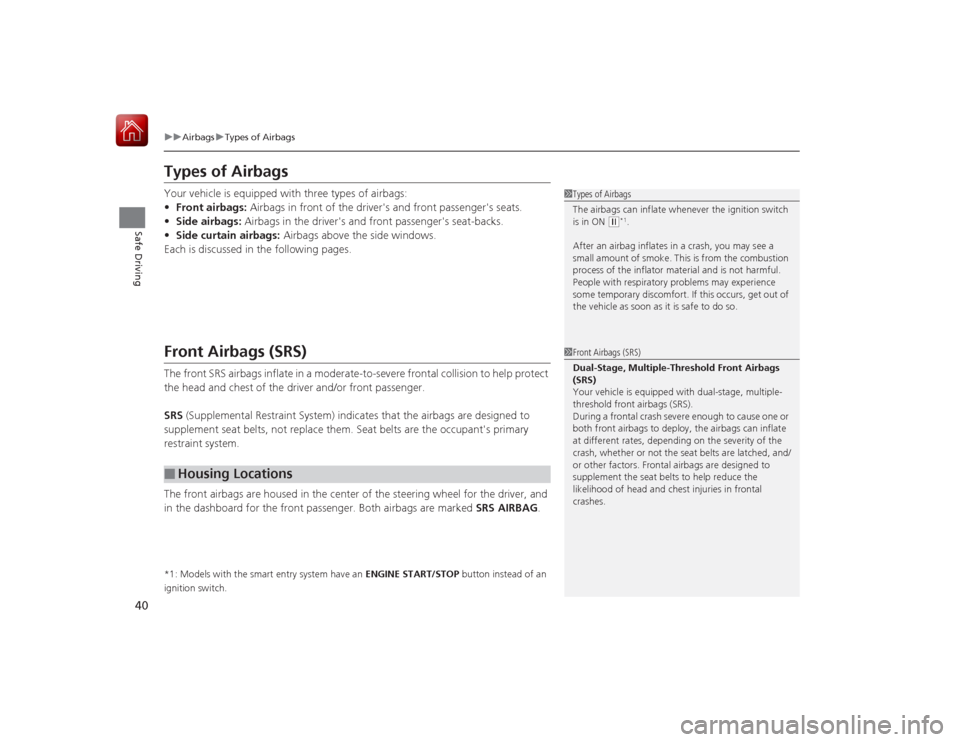
40
uuAirbags uTypes of Airbags
Safe Driving
Types of AirbagsYour vehicle is equipped with three types of airbags:
• Front airbags: Airbags in front of the driver's and front passenger's seats.
• Side airbags: Airbags in the driver's and front passenger's seat-backs.
• Side curtain airbags: Airbags above the side windows.
Each is discussed in the following pages.Front Airbags (SRS)The front SRS airbags inflate in a moderate-to-severe frontal collision to help protect
the head and chest of the driver and/or front passenger.
SRS (Supplemental Restraint System) indicates that the airbags are designed to
supplement seat belts, not replace them. Seat belts are the occupant's primary
restraint system.
The front airbags are housed in the center of the steering wheel for the driver, and
in the dashboard for the front passenger. Both airbags are marked SRS AIRBAG.*1: Models with the smart entry system have an ENGINE START/STOP button instead of an
ignition switch.■
Housing Locations
1 Types of Airbags
The airbags can inflate whenever the ignition switch
is in ON
(w*1.
After an airbag inflates in a crash, you may see a
small amount of smoke. This is from the combustion
process of the inflator ma terial and is not harmful.
People with respiratory problems may experience
some temporary discomfort. If this occurs, get out of
the vehicle as soon as it is safe to do so.
1 Front Airbags (SRS)
Dual-Stage, Multiple-Threshold Front Airbags
(SRS)
Your vehicle is equipped with dual-stage, multiple-
threshold front airbags (SRS).
During a frontal crash severe enough to cause one or
both front airbags to deploy, the airbags can inflate
at different rates, depending on the severity of the
crash, whether or not the seat belts are latched, and/
or other factors. Frontal airbags are designed to
supplement the seat belts to help reduce the
likelihood of head and chest injuries in frontal
crashes.
Page 47 of 441
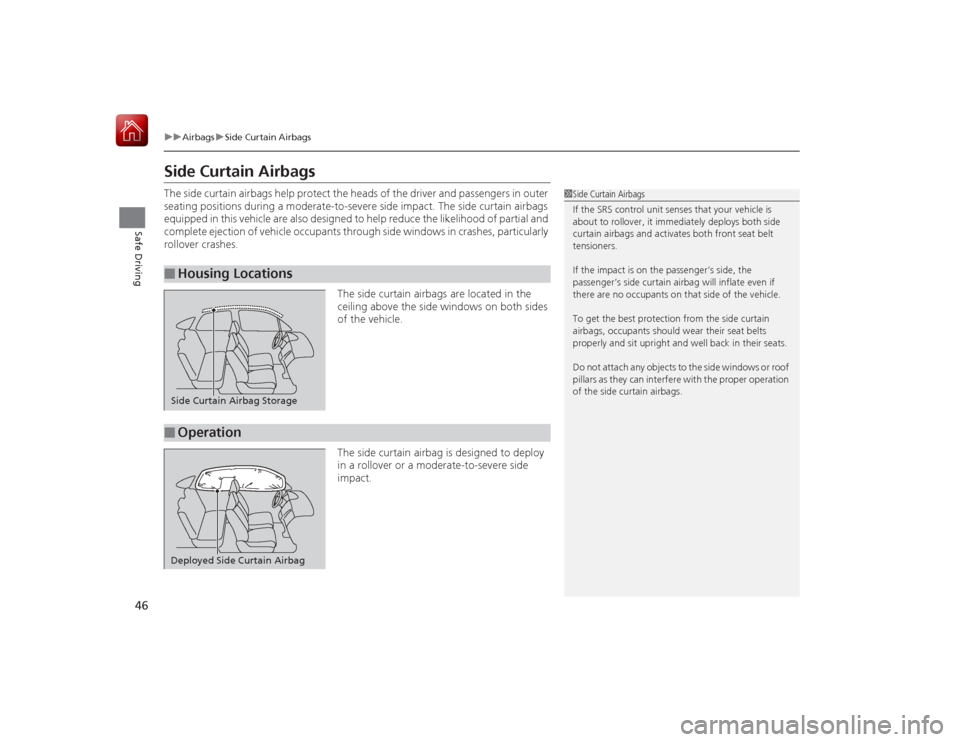
46
uuAirbags uSide Curtain Airbags
Safe Driving
Side Curtain AirbagsThe side curtain airbags help protect the heads of the driver and passengers in outer
seating positions during a moderate-to-severe side impact. The side curtain airbags
equipped in this vehicle are also designed to help reduce the likelihood of partial and
complete ejection of vehicle occupants through side windows in crashes, particularly
rollover crashes.
The side curtain airbags are located in the
ceiling above the side windows on both sides
of the vehicle.
The side curtain airbag is designed to deploy
in a rollover or a moderate-to-severe side
impact.■
Housing Locations
1Side Curtain Airbags
If the SRS control unit senses that your vehicle is
about to rollover, it immediately deploys both side
curtain airbags and activates both front seat belt
tensioners.
If the impact is on the passenger’s side, the
passenger’s side curtain airbag will inflate even if
there are no occupants on that side of the vehicle.
To get the best protection from the side curtain
airbags, occupants should wear their seat belts
properly and sit upright and well back in their seats.
Do not attach any objects to the side windows or roof
pillars as they can interf ere with the proper operation
of the side curtain airbags.
Side Curtain Airbag Storage■
OperationDeployed Side Curtain Airbag
Page 52 of 441
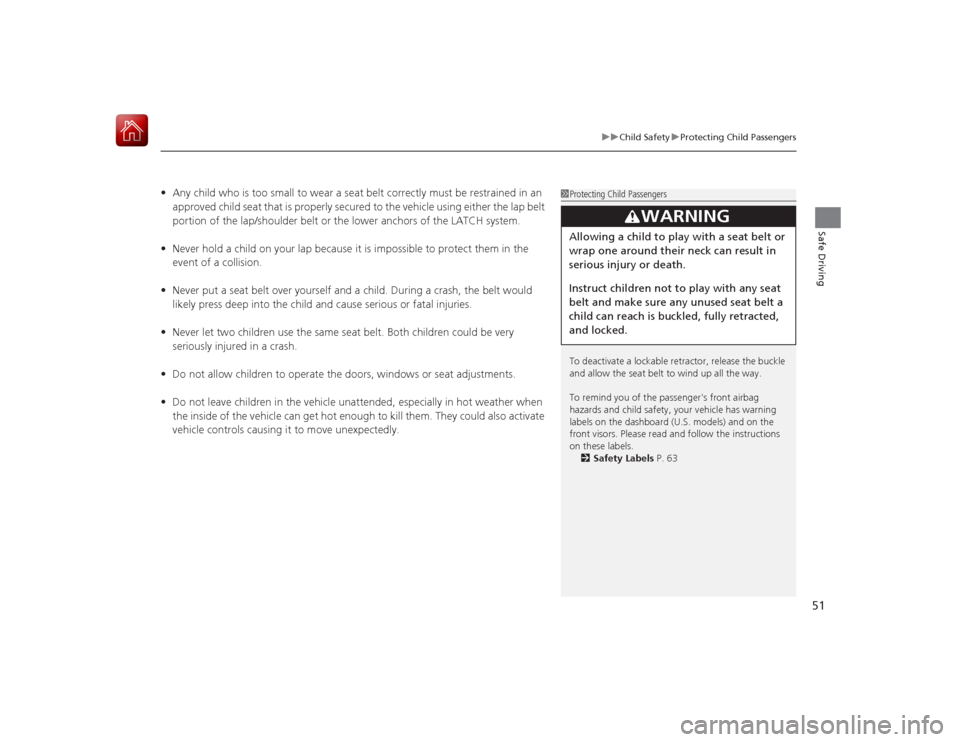
51
uuChild Safety uProtecting Child Passengers
Safe Driving
• Any child who is too small to wear a seat belt correctly must be restrained in an
approved child seat that is properly secured to the vehicle using either the lap belt
portion of the lap/shoulder belt or the lower anchors of the LATCH system.
• Never hold a child on your lap because it is impossible to protect them in the
event of a collision.
• Never put a seat belt over yourself and a child. During a crash, the belt would
likely press deep into the child and cause serious or fatal injuries.
• Never let two children use the same seat belt. Both children could be very
seriously injured in a crash.
• Do not allow children to operate the doors, windows or seat adjustments.
• Do not leave children in the vehicle unattended, especially in hot weather when
the inside of the vehicle can get hot enough to kill them. They could also activate
vehicle controls causing it to move unexpectedly.
1Protecting Child Passengers
To deactivate a lockable retractor, release the buckle
and allow the seat belt to wind up all the way.
To remind you of the passenger's front airbag
hazards and child safety, your vehicle has warning
labels on the dashboard (U.S. models) and on the
front visors. Please read and follow the instructions
on these labels.
2 Safety Labels P. 63
3
WARNING
Allowing a child to play with a seat belt or
wrap one around their neck can result in
serious injury or death.
Instruct children not to play with any seat
belt and make sure any unused seat belt a
child can reach is buckled, fully retracted,
and locked.